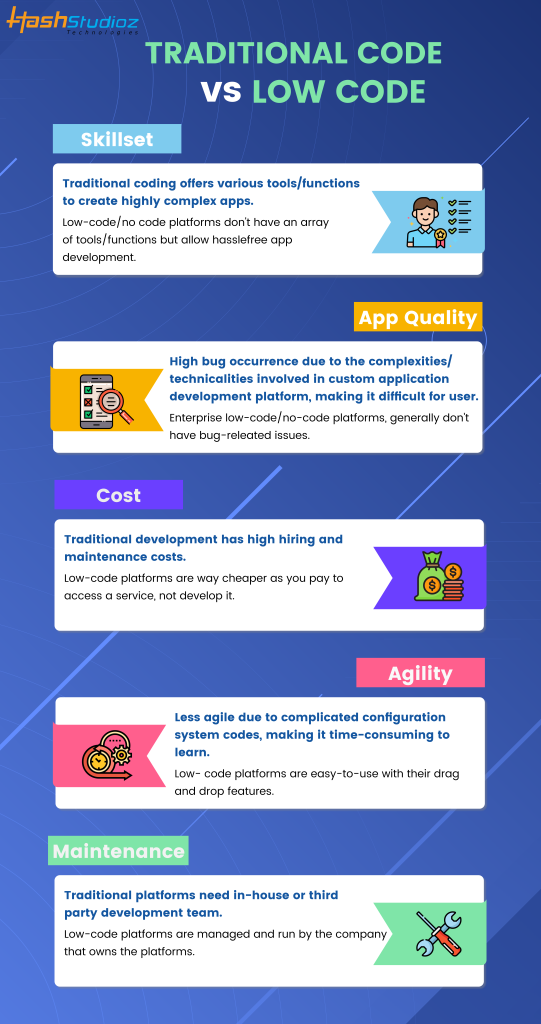Free Reasons For Choosing Low-Code Platform Sites
Wiki Article
Benefits Of Low-Code Application Development In Terms Of Integration Capabilities
Low-code app development has many advantages, particularly in terms of integration. This is important for creating applications that can seamlessly connect with systems and other services. Here are some of the benefits that come with pre-built connectors, APIs and other tools:
A Wide Range of Connectors : Low-code platforms usually come with a large library of pre-built connectors to popular enterprise systems (e.g. ERP CRM, databases and cloud services). This eases the process of connecting these systems.
API Integration: Many low-code platforms provide out-of-the-box API integration capabilities, allowing developers to connect to other service and data sources easily.
Simple to Use:
Drag-and-Drop Integration: Integration tasks can often be accomplished using drag-and-drop interfaces, making it accessible to both developers and non-developers to design complex integrations, without writing lots of code.
Visual Workflow builders Visual Workflow Builders used for designing workflows, data flow, and integrations. They help with understanding and setting them up more intuitively.
Standardized Integration Methods:
SOAP and restful services: Supporting web service common protocols such as REST or SOAP allows integration with a an array of systems and applications.
OData and Other Standards Support for other standards such as OData provides easy access to and manipulation of data on various platforms and software.
Real-Time Data Synchronization:
Low-code platforms permit real-time integration between systems and applications. This allows information to be updated and consistent across all departments of the company.
Event-Driven architecture: Certain platforms can support event-driven architectures. This allows apps to react to events in real time that is vital for dynamic and interactive apps.
Legacy System Integration:
Low-code Platforms: These can be used to connect older systems to modern systems. They're a great method to modernize your IT infrastructure, without having to redesign everything.
Data Migration Tool: Built-in migration tools let data be transferred from legacy systems to new applications that are built on low code platforms.
Integration of Third-Party Services:
Integration with Cloud Services: Seamless integration with cloud services such as AWS, Azure, and Google Cloud allows for the simple deployment and scaling of applications.
Integration of Business Applications: Lowcode platforms can be used to integrate different business applications, such as Salesforce, SAP, Microsoft Dynamics etc. to create a seamless workflow that spans different functions of business.
Simplified Data Management:
Unified Data Models: A few low-code platforms offer unified data models that simplify the management of data and integrate across different systems.
Data connectors: These preconfigured data connectors provide easy access and manipulation to data from multiple sources.
Security and Compliance
Secure Integrations: Low-code systems ensure that integrations comply with security protocols and standards, assisting to protect data during transit and in storage.
Compliance Features: These platforms include features that ensure integrations comply with regulatory requirements (e.g. GDPR, HIPAA), giving companies that handle sensitive information peace of mind.
Extensibility:
Low-code platforms are able to accommodate complicated integration requirements by incorporating custom scripts or code. They provide flexibility, without compromising their user-friendliness.
Plug-in Ecosystem An ecosystem of plugins and extensions that can enhance the integration capabilities that allow users to include additional functions as they need.
Overall, integration capabilities in low-code application development platforms permit them to function as a strong platform to create integrated, efficient, scalable, and connected applications. They make it easier to connect disparate platforms. They also enhance data flow. Have a look at the recommended Low-code Platform for application development blog for more examples including rapid action development, azure sql, cross platform mobile development, app development platform, multiplatform mobile app development, rapid app development, rapid action development, software for app development, no code platforms, develop cross platform mobile app and more.

Low-Code App Development Has Many Benefits In Terms Of Cost-Effectiveness.
Low-code application development offers numerous advantages when it comes to cost-efficiency, making it an attractive option for businesses looking to optimize their development budgets while still delivering top-quality software. The main benefits are reduction in costs for development:
Reduced Coding: Low-code systems cut down on the amount of hand-coding required and helps developers save time and energy when building applications. This results in lower labor costs.
We require less developers: Development that is low-code takes shorter time, and it is simpler. This means that less developers are needed. This will drastically lower costs of staffing and hiring.
Faster time to market
Accelerated Development Cycle: Visual tools that are low-code and components facilitate rapid development of applications. This allows businesses to launch products faster. This will result in more rapid growth in revenue and enhance competitive positioning.
Rapid prototyping. Businesses can test quickly and create prototypes. This helps reduce time in the development process and permits rapid iterations built on feedback from users.
Low Maintenance Costs
Simplified Maintenance: Applications built on low-code platforms tend to be simpler to maintain because of their modular components and standard architecture. It reduces costs for maintenance and support.
Automated updates: Many low-code platforms automatically manage patches and updates, ensuring that applications are secure and up to date with no need for a lengthy manual intervention.
Efficient Resource Utilization:
Contributions from non-developers: Low-code platforms enable people who are not developers to take part in the process of development. This democratization in development lets employees and businesses work together, thus reducing the dependence on highly paid developers.
Improved Utilization Of IT Resources: IT teams can concentrate on strategic initiatives rather than being bogged with routine development work, improving the efficiency of their teams and productivity overall.
Modular Pricing Models that Scale:
Subscription-Based Pricing: Many low-code software providers offer flexible subscription-based pricing that can scale in line with the amount of the amount of usage. This allows business to be able to align their spending with the actual demands and growth, while avoiding huge initial costs.
Pay-as-you-go options Certain platforms permit businesses to pay only for what they use. This is particularly useful for small or new businesses that have limited budgets.
Costs of Third-Party Software reduced:
Built-in Functionalities: Low code platforms have a variety of built-in features and integrations, which reduce the need for third-party tools and software. License and subscription charges are also reduced.
Pre-Built Integrations: Having pre-built integrations with the most popular services and systems reduces custom development. Time savings as well as money.
Improved ROI
More efficient return on investment Rapid development, lower cost, and faster time to market, means that businesses can achieve a faster return on investment (ROI) for their software.
Enhanced Agility - Businesses can quickly adapt to changes in market and changing customer needs. This lets them stay relevant and capitalize on opportunities that arise.
Reduced Cost of Training
User-Friendly Interfaces: The intuitive interfaces and user-friendly features of low-code platforms minimize the learning curve, thus making it less necessary to conduct extensive training.
Accessible Resources A lot of low-code platforms provide complete training materials, tutorials, and community support, further lessening the need for formal training and associated expenses.
Streamlined Collaboration:
Enhanced Collaboration Tools: Built-in collaboration tools facilitate better communication and coordination between team members, leading to more efficient development processes and reduced project overhead.
Unified Development Environment. An unified development platform helps reduce costs and streamline workflows through simplifying the management of various tools.
The overall cost-effectiveness of low-code application development stems in its ability to lower the cost of development and maintenance and speed up the time to market, improve resource utilization, and provide flexible pricing models. These factors provide substantial financial rewards to businesses. Low-code development is an excellent choice for organizations that want to increase budgets while still being able to create robust, scalable and high-quality software. Check out the best Enterprise application development with Low-code Platform for website examples including low code development platforms, azure sql, no code platforms, develop web application, ms azure sql, sso azure, stored sql procedures, rapid application design, build a docker container, cross platform app development and more.

Advantages Of Low-Code Application Development In Terms Of Limitations And The Possibility Of Customizing
The low-code approach offers an unbiased method that allows for extensive customization, and also addresses the issues. These are the main advantages: Handling Limitations
: .
Low-code development platforms are simpler to use due to the fact that they come with pre-built components, templates, as well as other tools. They also facilitate faster deployment of complicated applications.
A lot of platforms offer automated workflows that help developers navigate through complicated processes. They decrease the chances of error and maintain consistency.
Scalability Solutions
Scalability is built into: Low-code platform often includes features that allow for an architecture that is scalable. Applications can handle increasing demands with little changes.
Performance Monitoring: The integrated tools for monitoring performance and optimization can ensure that applications remain efficient when they grow.
Security and Compliance
Integrated Security Features: Low-code platforms come with built-in security measures such as encryption, access control based on role, and automated compliance checks, addressing common security concerns.
Platforms update frequently their security protocols, and ensure that they are in compliance with the regulatory requirements. This helps keep platforms safe from new threats.
Customization capabilities:
Extensibility:
Custom Code Integration: Low-code systems typically allow the integration of custom codes (e.g., JavaScript, Python) that allows developers to expand the capabilities beyond the standard offerings.
Custom Modules and Plugins: Developers have the option to create customized modules or plugins to tailor specific functions to meet the specific requirements of a particular business.
APIs and Integration
API Support - Complete support of APIs facilitates seamless integration with other services and systems, and allows for extensive customisation.
Low-Code Platforms: These platforms provide pre-built connectors to popular third-party service providers, making it simple to connect and modify apps.
Flexible UI/UX:
Customizable Interfaces: Developers have the ability to create and alter user interfaces in line with specific usability and branding criteria, resulting in a customized user experience.
Responsive Web Design Responsive Web Design: Built-in design responsive capabilities permit applications to be tailored in accordance with the size of the screen and the device.
Business Logic Customization
Visual Workflow builders This tool lets developers create complex processes with little or no programming. They can create business processes and workflows visually.
Conditional Logic and Scripting: Platforms permit the inclusion of conditional logic as well as custom scripting to handle specific business rules and scenarios.
Data Management:
Custom Data Modeling: Designers create custom models that meet specific requirements for the particular application. They can customize data handling to the business's needs.
Advanced Data Processing: Integration and advanced data handling tools allow for customisation of data analysis and usage in the program.
Balancing Limitations with Customization:
Frameworks, Standards and Standards:
Best Practices in Compliance Low-code platforms promote the use of industry-leading practices and standards, which helps in maintaining high-quality, flexible, and secure apps.
Governance Frameworks Governance Frameworks: Integrated governance frameworks ensure that the customizations do not compromise the integrity, compliance, or the security of an application.
Feedback and iterative development:
Rapid prototyping: The ability to quickly prototype and test customizations ensures that developers can modify their designs based on feedback from users and refine the application to better satisfy the user's needs.
Continuous Improvement: Platforms with low-code support for continuous improvement that allow customization and enhancement when the requirements of business evolve.
User Empowerment
Giving Citizen Developers the tools they need In allowing non-developers make customizations through intuitive user interfaces, platforms that do not require code expand the pool of contributors who can improve and customize applications.
Support and Training: A lot of platforms offer a wealth of assistance and training to help users to make effective modifications without compromising stability or performance.
Low-code development is a potent framework that permits a lot of flexibility while also addressing issues. This balance ensures that businesses can develop and maintain applications that are functional and customized to meet their particular requirements, while also maintaining high standards of security, quality and scaling.
